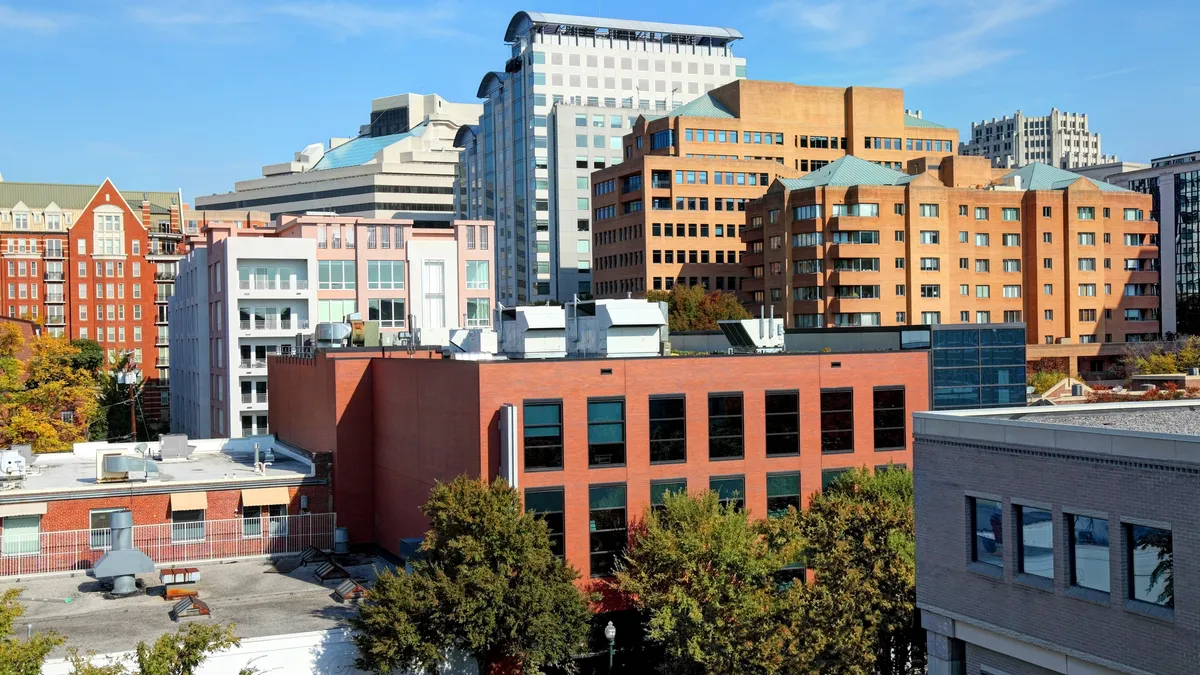More cities plan to advance policies that generate “cleaner, healthier, and more affordable buildings” by April 2024 since the Biden administration formed the Building Performance Standards Coalition just over six months ago.
Building performance standards that establish specific energy use or emissions performance targets are one tool cities can implement to slash pollution from the built environment. Unlike certain forward-looking parameters for construction, like building codes, standards can be used to hold existing buildings accountable.
Boulder, Colorado, and Montpelier, Vermont, have joined the coalition since January, according to the nonprofit Institute for Market Transformation, which supported the coalition’s launch. In California, Los Angeles County and the city of San Diego have also reportedly signed on, adding to the initial list of 33 state and local governments, which represented nearly 20% of the nation’s building stock.
While few of the committed governments have yet imposed new building performance standards, the list of cities signing onto the coalition is poised to expand further, said Ryan Freed, IMT’s senior director for policy and regulatory strategy.
“The combination of this really hot summer, the continued increase in climate disasters, and people starting to see how buildings fit in with the conversations around equity and economics and their community are driving people to see the need to act on buildings now,” Freed said.
Further incentives for building electrification, an emissions-reduction strategy, could come from proposed tax credits in the Inflation Reduction Act and a $500 million carve-out in Defense Production Act spending partly targeted for heat pumps.
New policies created by coalition members would build on those adopted in previous years by Washington, D.C.; St. Louis; New York City; and Washington state. This spring, coalition member Montgomery County, Maryland, passed a building energy performance standard policy that was in motion long before the coalition was announced — as did its home state.
Montgomery County’s bill was signed into law in May. Councilmember Tom Hucker said that pursuing such a policy became particularly important to the county after it declared a climate emergency in 2017. The county, Hucker said, recognized that energy use in the residential and commercial building sectors is its No. 1 polluter, contributing half of its total greenhouse gas emissions.
One challenge the county navigated as it crafted its policy, Hucker said, was its inability to impose hefty penalties on building owners that don’t comply with new regulations, as other local governments have done. Under state law, Hucker said, the county was unable to assess large fines: “It'd be like if we had parking tickets that cost a quarter.”
The county instead focused on creating a strong incentive program, including low-interest loans for building owners. Hucker stressed the importance of working with a range of stakeholders, including climate activists and building owners, as well as other local or state governments developing their own standards and complementary policies.
Moving forward
White House officials said they remain bullish on coalition cities’ influence in driving the adoption of building performance standards more broadly, including at the state level.
"Our rationale has been that having Savannah, having Atlanta, helps us start to figure out Georgia,” said Mark Chambers, who recently served as the White House Council on Environmental Quality’s senior director for building emissions and community resilience until the end of July.
“Because this thing plays itself out in the built environment, there is something to be said for having these points that are going through local legislature or local regulation,” he said. Cities and counties have figured out how to build coalitions locally as well, he added.
Chambers said technical assistance from agencies like the U.S. Department of Energy remains available to state and local governments in the coalition. He also pointed to the administration’s June launch of a national initiative to advance building codes, which aims to spur jurisdictions to modernize their construction requirements to be more energy efficient and resilient to hazards exacerbated by climate change.
Additional standards aren’t necessarily imminent. IMT isn’t aware of any coalition member that has ordinance language on a council agenda, but it pointed to Portland, Oregon, as one city in the process of hosting stakeholder meetings on this topic. Freed foresees a significant uptick in policies being passed in mid- to late 2023 and into 2024.
Going forward, Freed is optimistic jurisdictions will continue to learn from one another and create increasingly comprehensive building performance policies that heavily incorporate community involvement to better avoid potential unintended consequences. One of the chief concerns with requiring the shift from gas to electric, for example, is that the cost of a building upgrade would reduce affordability.
Governments also must take steps beyond writing standards to ensure they can support the decarbonization transition, Freed said.
“If we're going to be making massive amounts of improvements, there's going to be job opportunities created from that,” Freed said. That raises questions about who will be trained and available for those jobs and how quickly those jobs are are going to ramp up. “All of that has to be considered up front when you're building the policy. It's not all written directly in a performance standard, but it is a responsibility of building their BPS,” Freed added.




















